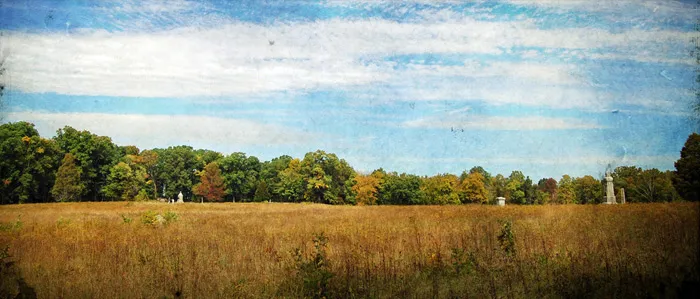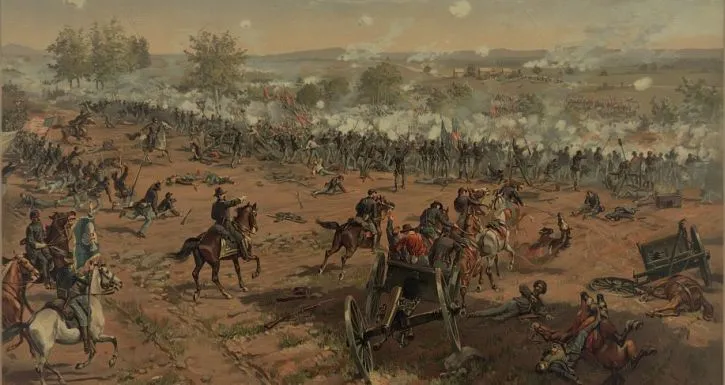10 Facts: Gettysburg

It is the site of the bloodiest battle of the Civil War and one of the most visited places in the United States, but Gettysburg is still plagued by misinformation. Set the record straight with these ten key facts.
Fact 1#: The battle was fought at Gettysburg because of the area road system—it had nothing to do with shoes.
The Town of Gettysburg, population 2,000, was a town on the rise. It boasted three newspapers, two institutes of higher learning, several churches and banks, but no shoe factory or warehouse. The ten roads that led into town are what brought the armies to Gettysburg. The shoe myth can be traced to a late-1870s statement by Confederate general Henry Heth.
Fact #2: The First Day’s battle was a much larger engagement than is generally portrayed.
The first day’s fighting (at McPherson’s Ridge, Oak Hill, Oak Ridge, Seminary Ridge, Barlow’s Knoll and in and around the town) involved some 50,000 soldiers of which roughly 15,500 were killed, wounded, captured or missing. The first day in itself ranks as the 12th bloodiest battle of the Civil War—with more casualties than the battles of Bull Run and Franklin combined.
Fact #3: The Second Day’s Battle was the largest and costliest of the three days.
The second day’s fighting (at Devil’s Den, Little Round Top, the Wheatfield, the Peach Orchard, Cemetery Ridge, Trostle’s Farm, Culp’s Hill and Cemetery Hill) involved at least 100,000 soldiers of which roughly 20,000 were killed, wounded, captured or missing. The second day in itself ranks as the 10th bloodiest battle of the Civil War—with far more casualties than the much larger Battle of Fredericksburg.

Fact #4: Of 120 generals present at Gettysburg, nine were killed or mortally wounded during the battle.
On the Confederate side, generals Semmes, Barksdale, Armistead, Garnett, and Pender (plus Pettigrew during the retreat). On the Union side, generals Reynolds, Zook, Weed, and Farnsworth (and Vincent, promoted posthumously). No other battle claimed as many general officers.
Fact #5: Culp’s Hill and Cemetery Hill were far more important than Little Round Top.
While Little Round Top is far more popular today, its importance to the Union army is at least debatable. The same cannot be said for Culp’s Hill and Cemetery Hill. The two latter hills formed the center and right of the Union’s main position and also protected the Union army’s only real lifeline on July 2 and 3—the Baltimore Pike. Had Confederates captured and controlled either of these two hills, the Union army would have had to leave the Gettysburg area. It is as simple as that. Even with its sweeping views and commanding height, the same cannot be said for Little Round Top.
Fact #6: Pickett’s Charge was large and grand but by no means the largest charge of the Civil War. Not even close.
Pickett’s Charge involved some 12,000 Confederate soldiers, but the Confederate charge at Franklin had roughly 20,000. Even that pales in comparison to the grand Confederate charge at Gaines’ Mill which involved more than 50,000 Confederate troops. Even the well-known 260-gun bombardment that preceded Pickett’s Charge was not the largest of the war. There was at least one bombardment at Petersburg with more than 400 cannons involved.

Fact #7: The Battle of Gettysburg is by far the costliest battle of the Civil War but not necessarily the largest.
While each of the three days of the Battle of Gettysburg rank in the top 15 bloodiest battles of the Civil War—the 160,000 troops present at Gettysburg are eclipsed by the more than 185,000 at Fredericksburg.
Fact #8: 64 Medals of Honor awarded to Union soldiers for their actions at Gettysburg
The deeds spanned the battlefield and were awarded from wartime into the 21st century. Eight were awarded for actions on July 1, 28 for actions on July 2, and 29 for actions on July 3. The most recent Medal of Honor given for heroism at Gettysburg was awarded to Alonzo Cushing by President Barack Obama in 2014.
Fact #9: The Gettysburg Address essentially said the same thing as the famous orator Edward Everett’s speech but in 1/60th the time.
When Lincoln uttered these two sentences, “We have come to dedicate a portion of that field as a final resting place for those who here gave their lives that nation might live. It is altogether fitting and proper that we should do this,” he was essentially repeating an idea that had already been stated—only more succinctly. Everett used more than 5,500 words (the entire speech can be found here) to make the same point. Most every part of the corresponding speeches can be examined this way and leaves no doubt as to why Everett wrote to Lincoln: "I should be glad, if I could flatter myself that I came as near to the central idea of the occasion, in two hours, as you did in two minutes."
Fact #10: While the Gettysburg Battlefield is well-preserved, there are still numerous parcels to be saved.
The Civil War Trust and the National Park Service have identified several unpreserved parcels which are important to the story of America’s greatest battle. The battlefield itself is among the best resources for historians and others to learn about the battle. The unique terrain, when used in conjunction with the words of those who fought here, images created on the ground, and monuments placed by the veterans, provides an unparalleled learning opportunity. We must continue to work to preserved this hallowed ground.
Learn More: Gettysburg Animated Map
We're on the verge of a moment that will define the future of battlefield preservation. With your help, we can save over 1,000 acres of critical Civil...
Related Battles
23,049
28,063





